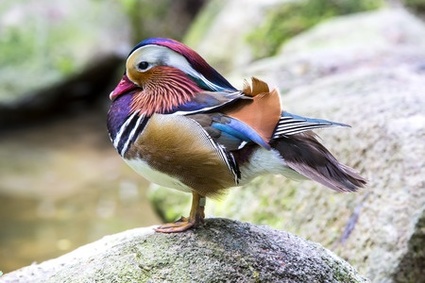
Take, for example, the richly colored tropical fish you see swimming around in aquariums, or, if you are fortunate, that you may have seen in some tropical ocean. Most people think those fish just evolved that way because their bright colors gave them some survival advantage over dull grey fish. But there are still plenty of dull grey fish in every ocean and they seem to be doing OK. That’s not to say that the colors in nature don’t have any use, but often they are not really as necessary as you might think.
Flowers could have survived just fine if they were all one or two bright colors to attract insects where necessary, but there are thousands of colors in the floral world. Birds and tropical fish could have survived with a much more limited palette of colors, too, but again, we see thousands of colors in these creatures – colors that are far more wide-ranging than is needed for members of species to recognize each other, or for any other practical reason. Nature has a superabundance of colors – and humans, especially, are designed to enjoy them. The human eye can recognize nearly ten million distinct colors, and although we don’t need to be able to see so many colors in order to survive, the ability adds immeasurably to our enjoyment of the world in which we live.
But it could have been a black and white world. There is no reason to believe a black and white world would not work any more than a black and white TV could not work, but if you have a color TV, would you want to go back to black and white? We all know the answer to that question. The truth is, we love color and color adds tremendously to the enjoyment of watching a film or television program. The creation is no different. Whether we realize it or not, color is a gift we were given and one that helps us see something about the mind of God.
Usually we think of the creation as showing God’s intelligence in his design and provision for the many life forms of this world, but we can also see other traits – including his love – in the colors of the creation.
If your parents were inestimably rich and gave you a TV as a gift, would you think they loved you more if they gave you a black and white TV or a color TV, if they could afford either? Color is obviously an important part of the gift. That is why we see examples of multiple colors being associated with gifts of love in the Bible. Think for example of Joseph’s coat of many colors and notice why it was given him: “Now Israel loved Joseph more than any other of his sons … And he made him a robe of many colors” (Genesis 37:3). Joseph’s father would still have loved him if he had given him a dull grey coat, but he loved him greatly and, as a result, gave him that coat of many colors. And it wasn’t just Joseph – we see other beloved individuals with many-colored coats in the Bible (2 Samuel 13:18, Psalm 45:14, etc.).
In the same way, color is not just a part of Gods’ creation, it is a gift that he has given to us. He could have made everything black and white, but in love he made us capable of seeing millions of colors and built a superabundance of color into the creation for us to enjoy. Next time you see a sunset, an iridescent tropical fish or a brightly colored bird or flower, think about it. Do you just see colors – or do you see God’s love expressed in the gift of color?
 RSS Feed
RSS Feed
